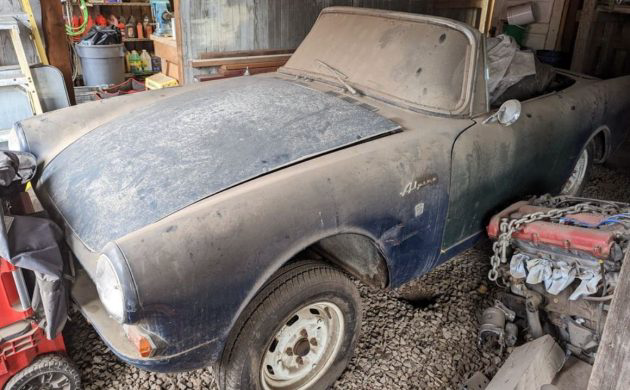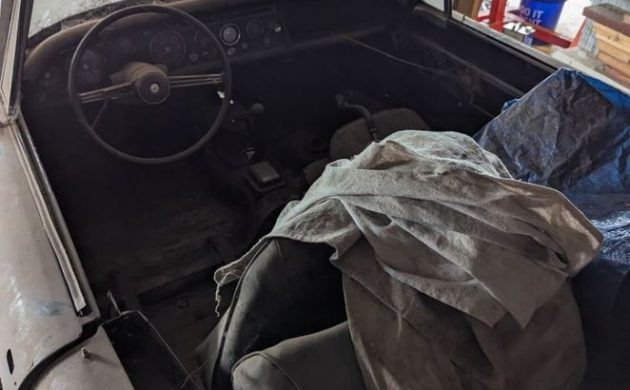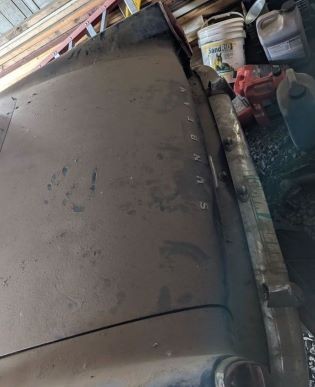Sunbeam’s Alpine nameplate was recycled over the course of more than two decades, putting thousands of Alpines of one sort or another on the roads. The first of these descended from the Sunbeam-Talbot saloon and was famous for its appearance in “To Catch a Thief”, driven by Grace Kelly. That Alpine was only produced for three years. The iteration more familiar to us – used as the basis for the Tiger – was created by a man who, despite a lifetime of industrial design work including stints with Raymond Loewy at Studebaker and with Ford’s Thunderbird division, registered only this single, complete car in his resume. Kenneth Howes accepted the assignment from Rootes Group in 1956 to revise the Alpine so it could compete with the Triumph TR3 and MG’s MGA. The resulting car was considerably more civilized – with roll-up windows, front disc brakes, and external door latches – but it was hampered by the Rootes organization itself. The chassis was derived from the Hillman Husky estate – with nary a sporting bone in any of its DNA – and the remainder of the parts were largely already in the bins at Rootes destined for some dowager of the Rootes line-up previously put on the ground. Nonetheless, the car achieved sales of around 70,000 copies until it was finally sunsetted in 1968.
The car we are considering today is an abandoned project, which in this case means the engine is already separated from its berth in the car. Not only that but it’s also been separated from its cylinder head, which was missing from the git-go when our seller bought this Sunbeam. I do recognize that debris atop the rearmost cylinder; who hasn’t had the occasional project housing a squirrel in the engine? Anyway, this being the Series V Alpine, the engine is a 1725 cc five-main in-line four-cylinder, coupled with two Zenith Stromberg carburetors, and good for 93 hp. With its all-synchro four-speed gearbox, the Alpine was a genuine 100 mph car, but it was still a bit slower than the MGB. The recirculating ball steering wasn’t as crisp as the MGB’s rack and pinion, and the Alpine’s suspension was tuned for more travel than the typical sports car, softening its ride.
Apart from the question mark of the engine, we’re left to judge the interior by this photo. Other than the steering wheel which is obviously present, and I think I see gauges, I’ll let the reader draw his own conclusions – please tip us off in the comment section if you can see more than I do.
By the time 1967 rolled around, the car’s fins had been tamed. Personally, I like the extravagant fins and would opt for that early body style, perhaps replacing the 1500 cc engine with a Series V motor. But others prefer the restrained styling of the later cars. This blue ’67 Alpine is listed here on facebook Marketplace, for $3000, and it’s located in Rohnert Park, California. Gunter Kramer sent us this tip – but do we think this is a good deal? Prices for these underloved British roadsters have been on the rise in recent years, even without considering the obvious possibility of a makeover into a “Tiger”. The Alpine is still sporting while giving up the harshness of its more primitive competitors, the cabin is roomy, and the styling – cast against the negative evolution of modern cars – is enjoying a renaissance of favor. A very nice Alpine will now cost around $20k or slightly more. Does that make this car seem a bargain, or not?






It’s very important to check for rust on the unibody portion of the car, particularly where the rear springs attach. If they are OK, the car might be worth $750 to $1,000
I had a good friend who attempted to destroy an alpine at the end of his ownership. VERY difficult to do. The Tiger engine supported by a very stout frame was nearly indestructible. A very nice car capable of the V8 transplant.
I like the looks– and agree that the earlier taller tail fins were NOT out of place- and gave the car a distinctive flair. Both are appealing to me. I also owned a Husky Wagon for a while. THAT is even MORE unique. Way too much fun! HA! Too many projects- however–as the price is right- and in my neighborhood…… Oh Well- in another lifetime.
It all comes down to how sound the body is.
A cloned Tiger is always tempting, but the purists sneer at them. And there are quite a few options for smaller, all-aluminum inline fours that will outperform the V8s put in the Tigers anyway, without making the front heavy enough to understeer.
I wonder if the owner’s original idea was to fit the twin-cam motor that’s sitting beside it?
I actually owned a ’67 Alpine, 1725cc, twin Strombergs. Parts guy said mine was a 67 and a half due to the Strombergs.”the Alpine was a genuine 100 mph car”, mine would go nearly that fast in third gear. Shame to see one in this condition.
What a mess. And the owner calling it a Chrysler Sunbeam Alpine?
A friend had one when we were kids and it was was kind of a wannabe sports car.
Has everyone forgotten Sean Connery as James Bond driving a blue Alpine in the 1962 production of “Dr. No.” Did watching 007 out drive and out maneuver the VooDoo hearse full of henchmen translate into an uptick in Sunbeam sales?
My father took me and my brothers to see Dr. No. This was just before our Mother blew up our 1955 Ford Ranchwagon. We kids campaigned for anything that wasn’t another blue Ford. He played along by taking us to look at lots of new cars including Alpines, Jaguars and Land Rovers. He was kind of excited by the Land Rover but in the end he bought a blue 1963 Ford Ranch Wagon. He liked the Alpine but also had 3 growing sons.